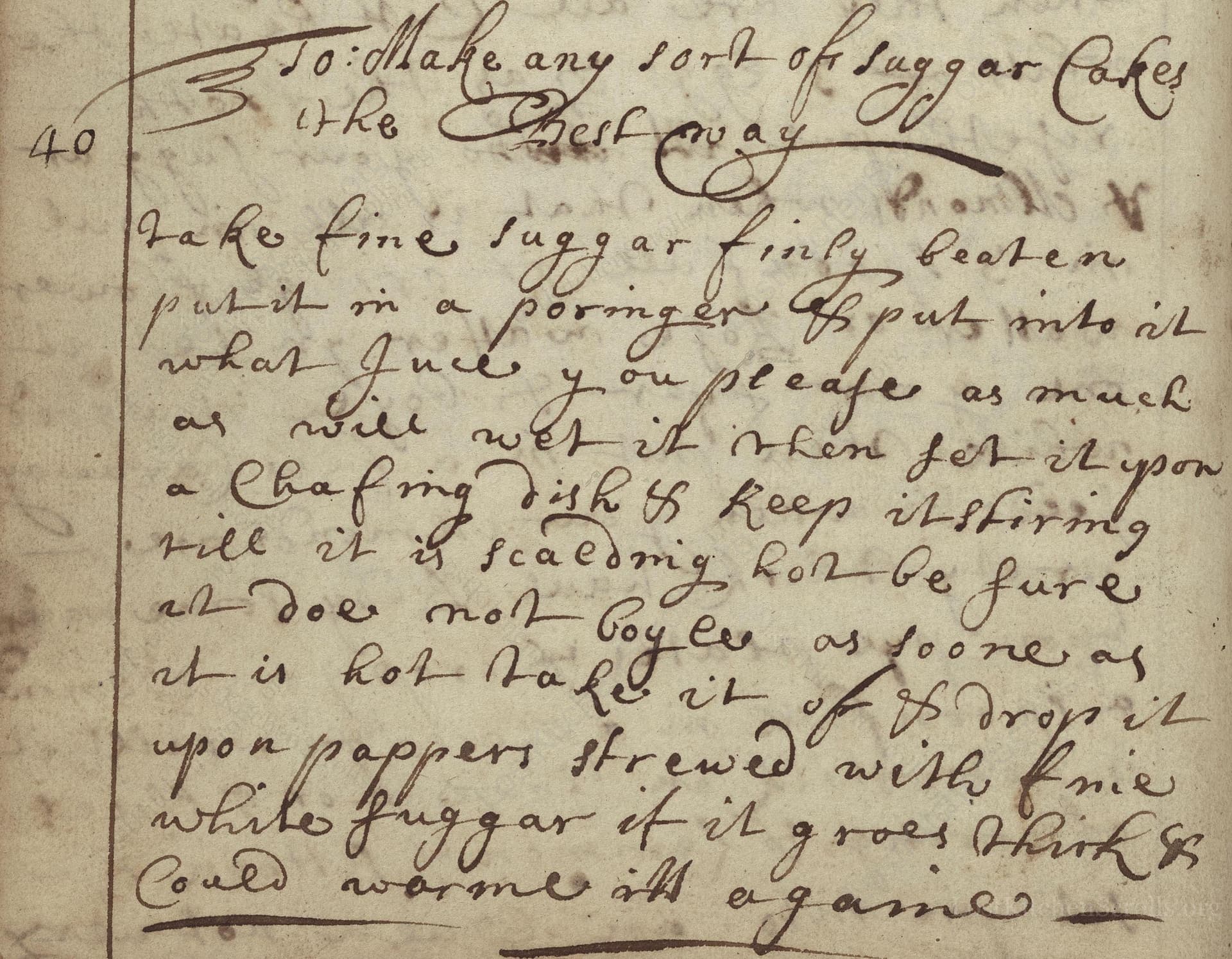To Make Any Sort of Sugar Cakes the Best Way
From the treasured pages of Receipt book of Penelope Jephson
Written by Penelope Patrick

To Make Any Sort of Sugar Cakes the Best Way
"Take fine suggar finly beaten put it in a poringer & put into it what Jues you please as much as will wet it then set it upon a Chafing dish & keep it stiring till it is scalding hot be sure it doe not boyle as soone as it is hot take it of & drop it upon pappers strewed with fine white suggar if it groes thinck & Could warme itt againe"
Note on the Original Text
This recipe was written in very plain, conversational prose, with little punctuation and broad spelling variations ('suggar', 'boyle', 'pappers'). Recipe writers of the time often assumed a good deal of knowledge on the part of the reader, and gave brief instructions focusing more on method than measured quantities or precise times. Unusual spellings and phonetic renderings are typical for the 17th century, underscoring both the evolving nature of English orthography and the oral tradition of cookery instruction of the period.

Title
Receipt book of Penelope Jephson (1673)
You can also click the book image above to peruse the original tome
Writer
Penelope Patrick
Era
1673
Publisher
Unknown
Background
Step back into the sumptuous kitchens of the late 17th century with Penelope Patrick’s culinary collection—a feast of historic recipes, secret tips, and the irresistible flavors of Restoration England all bound together in a handwritten treasure.
Kindly made available by
Folger Shakespeare Library
This recipe comes from the manuscript collection of Penelope Patrick (1646-1725), dating from around 1671 to 1675. During this period, sugar was still a prized luxury ingredient, often reserved for special occasions and the elite table, but by the late 17th century it was becoming more broadly accessible. 'Sugar cakes' like these were delicate confections served at gatherings, banquets, or as a sweet treat at the end of a meal, reflecting the increasing importance of sweets in European courtly and domestic life.

In the 17th century, the cook would have used a 'porringer'—a small handled bowl—set over a chafing dish filled with hot coals or embers to gently heat the sugar mixture. Stirring would be done with a wooden spoon. Drops of hot sugar paste would be placed with a spoon onto papers (as baking paper did not exist, often plain or slightly greased paper was used), and finely sifted sugar would be sprinkled both under and over to help prevent sticking and promote setting.
Prep Time
10 mins
Cook Time
5 mins
Servings
12
We've done our best to adapt this historical recipe for modern kitchens, but some details may still need refinement. We warmly welcome feedback from fellow cooks and culinary historians — your insights support the entire community!
Ingredients
- 7 oz superfine white sugar (or powdered sugar)
- 2–3 tbsp fruit juice of choice (e.g., lemon, orange, cherry, raspberry) (1–1.5 fl oz)
- Extra powdered sugar for dusting
Instructions
- Begin by finely grinding about 7 ounces of white sugar until it is a fine powder, much like modern powdered sugar.
- Place this sugar in a small heatproof mixing bowl.
- Choose any fruit juice you like, such as lemon, orange, or cherry; add just enough to moisten the sugar and create a thick paste (about 2–3 tablespoons or 1–1.5 fluid ounces).
- Place the bowl over a pot of simmering water to gently heat it (like a modern double boiler), stirring continuously until the mixture is very hot but not boiling—this will take around 3–5 minutes.
- Once hot, swiftly remove from the heat.
- Drop spoonfuls of the hot sugar paste onto baking parchment that has been dusted with a light layer of powdered sugar.
- If the mixture thickens as it cools, you may gently warm it again.
- Allow the cakes to set and cool completely before enjoying.
Estimated Calories
65 per serving
Cooking Estimates
Preparing the ingredients and mixing the sugar with fruit juice will take about 10 minutes. Cooking the mixture over simmering water will take around 5 minutes. This recipe makes 12 small sugar cakes, each with around 65 calories.
As noted above, we have made our best effort to translate and adapt this historical recipe for modern kitchens, taking into account ingredients nowadays, cooking techniques, measurements, and so on. However, historical recipes often contain assumptions that require interpretation.
We'd love for anyone to help improve these adaptations. Community contributions are highly welcome. If you have suggestions, corrections, or cooking tips based on your experience with this recipe, please share them below.
Join the Discussion
Rate This Recipe
Dietary Preference
Main Ingredients
Culinary Technique

Den Bockfisch In Einer Fleisch Suppen Zu Kochen
This recipe hails from a German manuscript cookbook compiled in 1696, a time whe...

Die Grieß Nudlen Zumachen
This recipe comes from a rather mysterious manuscript cookbook, penned anonymous...

Ein Boudain
This recipe comes from an anonymous German-language manuscript cookbook from 169...

Ein Gesaltzen Citroni
This recipe, dating from 1696, comes from an extensive anonymous German cookbook...
Browse our complete collection of time-honored recipes



